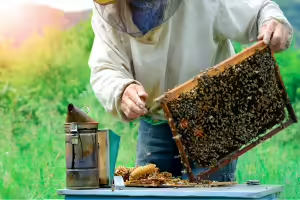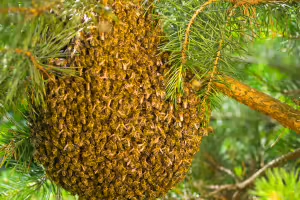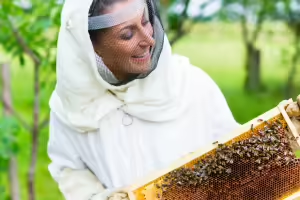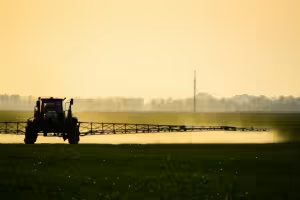Learn to be a Beekeeper
- Application for Apiary Registration - Illinois: All Beekeepers must register with the state (free of charge)
- Registration for DriftWatch - Illinois: Beekeepers may register with DriftWatch to enhance communication with pesticide applicators before sprays happen
- Agricultural Marketing Resource Center: Understand the honey bee market and find links to current market research
- Illinois Bees & Apiary Regulations: Be in the know about the Bees and Apiary Act.
- USDA Bees & Apiary Program: Go-to resource for Beekeeping
- Illinois State Beekeepers Association: Network with other Beekeepers Statewide
- Bee Health: Website rich in resources, from best management practices, honey bee health, basic beekeeping techniques, to queen rearing and bee breeding
Conservation Issues
- Drought Monitor: The U.S. Drought Monitor is produced through a partnership between the National Drought Mitigation Center at the University of Nebraska-Lincoln, the United States Department of Agriculture, and the National Oceanic and Atmospheric Administration.
- BeeSpotter: Web-based portal at the University of Illinois for learning about honey bees and bumble bees and for contributing data to a nationwide effort to collect baseline information on population status of these insects.
- Bee Removal Services: Bee Removal Source was developed to aid people who have discovered a honey bee hive living in an undesirable location.
- New Pesticide Labeling for Bee Protection: EPA Bee Advisory Box for Pesticide labels: A look at the EPA's pesticide label to protect pollinators
Research
- The Robinson Lab: Honey Bee Research at University of Illinois
- USDA Honey Bee Surveys and Reports: Reliable, up-to-date statistics provided by National Agricultural Statistics Service
- Attracting Wild Bees to Farms is a Good Insurance Policy: Investing in habitat that attracts and supports wild bees in farms is not only an effective approach to helping enhance crop pollination, but it can also pay for itself in four years or less, according to Michigan State University research.
- Bee Pastures May Help Pollinators Prosper: USDA Agricultural Research Service.
- Bee-Killing Parasite's Genome Sequenced: USDA Agricultural Research Service.
- Bees Exposed to Fungicide More Vulnerable to Nosema Parasite: USDA Agricultural Research Service. Study from the University of Maryland.
- Need Wild Bees? Plastic Totes Make A Superb Bee "Nursery": USDA Agricultural Research Service
Large Animals
Swine
- Conservation Practices in Outdoor Hog Production Systems: North Carolina State University Center for Environmental Farming Systems
- Forages for Swine: Use of good pasture containing alfalfa, ladino clover, and grass can lower sow feed costs, help maintain high level reproductive capacity of boars, and in many cases increase litter size as compared to confinement raising of hogs. University of Missouri Extension.
- Outdoor Pig Production: A Pasture-farrowing Herd in Western Iowa: Iowa State University
- Outdoor Pig Production: An Approach That Works: By Iowa State University and the Leopold Center for Sustainable Agriculture
- Swine: University of Illinois - Illinois Livestock Trail
- Swine Information - Louisiana State University: Publications, covering topics such as growing and finishing facility, gestation or finishing hog building, finishing floor, building designs, hog feeding units, etc.
Equine
- Companion animal and Equine Science: University of Illinois College of ACES
- Equine Herpesvirus (EHV-1): EHV-1 (equine herpesvirus-1) is one of a large group of DNA viruses that causes potentially serious disease in horses and other species, largely llamas and alpacas.
- Equine Infectious Anemia: EIA is a serious, sometimes fatal, blood disease in horses and other equine, including ponies, mules, asses, donkeys and zebras. Also known as swamp fever, mountain fever, slow fever or malarial fever, EIA infects the host's white blood cells. Illinois Department of Agriculture.
Beef
- 2018 Food Composition Tables - Beef: Beef Magazine
- Rapid Method for Measuring Feces NH3 and C02 Emmissions and Decomposition Rate Constants: A study demonstrating an approach for calculating CO2–C and NH3–N emissions and associated rate constants when feces were applied to bare soil or soil + vegetation. Published in Agronomy Journal Vol 109/Issue 4 - 2017.
Small Animals
Alpaca/Llamas
- AlpacaInfo - Alpaca Owners and Breeders Association: One of the goals of the Alpaca Owners and Breeders Association (AOBA) is to provide the public and members with information about Alpacas and the industry.
- Llamas and Alpacas: Penn State Extension
- USDA National Agricultural Library: Llamas and Alpacas
Sheep/Goats
-
An Introduction to Sheep Behavior: University of Illinois - Illinois Livestock Trail
- Are You Thinking of Raising Meat Goats?: University of Illinois - Illinois Livestock Trail
- Commodity Lamb Profile: USDA Agricultural Marketing Service
- Dairy Goats: 2018 - USDA Agricultural Marketing Resource Center.
- Dairy Sheep: Overview and resources. From the Agricultural Marketing Resource Center - 2018.
- Low Input Lambing & Kidding: A resource guide for managing lambing and kidding efficiently without sacrificing animal well being. Cornell University, January 2014.
- Making Pasture and Forages Work for Sheep: University of Illinois - Illinois Livestock Trail
- Organic Lamb Profile: Agricultural Marketing Resource Center
- Planning Sheep and Goat Fencing for Improved Animal Control and Reduced Predation: University of Illinois - Illinois Livestock Trail
- Sheep and Goats: What they can do for you: ATTRA Webinar on raising sheep and goats for profit.
- The Goat Industry: Structure, Concentration, Demand and Growth
- The Small Ruminant Toolbox: Sheep and goat enterprises offer diversification opportunities for small and limited-resource farmers. This Small Ruminant Toolbox was developed by the National Center for Appropriate Technology (NCAT) in order to provide a collection of information for small ruminant producers and educators. The Small Ruminant Toolbox includes many publications, presentations and other resources that will be helpful to small ruminant producers.
- USDA Organic; Substances for Organic Crop + Livestock Production: July 2013. The USDA National Organic Program (NOP) has released a new fact sheet summarizing allowed and prohibited substances in organic crop and livestock production and processing.
- Why Electric Fences Fail
Rabbits
- Commercial Rabbit Production: MIssissippi State University Extension Service - publication 1384.
- Rabbit Hemorrhagic Disease.: 2007 Publication from Iowa State University, College of Veterinary Medicine.
- Rabbit Production: PennState Extension. Written by Lynn Kime and Dr. Jayson Harper. 2005
- Rabbits - Alternative Farming Systems: USDA National Agricultural Library
- Rabbits Profile: Agricultural Marketing Resource Center publication
- Raising Meat Rabbits: 2005 Publication from Cornell University Cooperative Extension - Small Farms Program.
- Small-Scale Sustainable Rabbit Production: 2012 Publication from the National Sustainable Agriculture Information Service. Provides an introduction to small-scale rabbit production, focusing on meat rabbits and sustainable rabbit management.
- U.S. Rabbit Industry Profile - 2002
- USA Rabbit Breeders List
Poultry
Body
- 6 Ways To Prevent Poultry Diseases: Backyard Biosecurity
- Avian Influenza Basics for Organic and Pastured Poultry Flocks: Avian influenza information from the University of Minnesota Extension that is focused on the health management needs of the small poultry flock farmer.
- Department of Animal Sciences: College of ACES - University of Illinois
- Illini Poultry NET: University of Illinois online resource for the poultry industry.
- Pastured Poultry Production and Profitability: ATTRA Webinar. "Pastured Poultry Production and Profitability" covers the basics of pastured poultry production as well as common advantages and pitfalls of getting started in the business and keys to keeping operations profitable.
- U.S. EPA - Poultry Production: Background, production phases and systems, nutrition, manure handling systems environmental impacts, and references.
- USDA National Agricultural Library
- USDA Organic; Substances for Organic Crop + Livestock Production: July 2013. The USDA National Organic Program (NOP) has released a new fact sheet summarizing allowed and prohibited substances in organic crop and livestock production and processing.
- Emus, Ostriches, and Rheas: USDA National Agricultural Library
Title
Dairy
Body
- 2016 Integrated Pest Management Guide for Organic Dairies: Outline of practices for the management of external arthropod pests such as flies, lice, mites and grubs on organic dairy farms. Cornell University
- Amending Pasture Soils Improves Forage Quality and Economic Return: An Organic Dairy Case Study: Published by Dr. C.A. Daley, California State University, Chico.
- Dairy Focus Newsletter: University of Illinois Publication
- Dairy Food Processing - Federal Regulations: PennState Extension
- Dairy in Illinois - Illinois Department of Public Health
- Dairy in Illinois - Raw Milk Sales: Illinois Department of Public Health Department information and application for selling raw milk.
- Dairy Nutrition and Reproduction: Focused research and strategies for dairy farm profitability. University of Illinois, Department of Animal Sciences.
- Department of Animal Sciences: College of ACES - University of Illinois
- Fly Management in the Organic Dairy Pasture–eOrganic Webinar: In this webinar, Dr. Donald Rutz and Keith Waldron of the New York State IPM Program will address Organic Integrated Pest Management (IPM) for these and other pests begins with proper identification of pests, understanding biology, and realizing their importance in the production process.
- Illinois Livestock Trail: University of Illinois Extension online resource for the dairy industry
- Open or Problem Cows and Annual Costs Don't Add Up: James F. Grimes, Ohio State University Extension



